[orc]Recently, the ‘Save Nallamala’ movement gathered steam in Telangana with celebrities and others joining in. The demand was not to allow any Uranium mining in the Nallamalas. But, what is the issue all about? Here is a explainer with the timeline of all the various official documents.
The Ministry of Environment and Forests’ & Climate Change’s (MoEFCC) in-principle approval for survey and exploration of Uranium in Amrabad Tiger Reserve, by Atomic Minerals Directorate sparked a huge uproar in Telangana and led to the ‘Save Nallamala’ movement. The movement gained momentum when celebrities and politicians joined the campaign. The campaign bore fruit when the Telangana State Assembly passed a unanimous resolution requesting the Central government not to permit uranium mining operations in Nallamala forests.
Amrabad Tiger Reserve became the second largest tiger reserve of India following the bifurcation of Andhra Pradesh. The reserve, lying in the Nallamala hills, in the districts of Mahabubnagar and Nalgonda in southern part of Telangana, is the abode for a large diversity of flora and fauna. Chenchus, the food gathering and hunting primitive tribe classified as Particularly Vulnerable Tribal Group (PVTG) by Government of India are found in the foothills of these pristine hills.
Those campaigning against Uranium mining argued that if mining was permitted in this area, it would have had irreparable ecological implications including loss of biodiversity and possibility of contamination of river Krishna in addition to jeopardizing the lives of Chenchus, the PVTGs as declared by Government of India. But what about the procedure & law related to these approvals?
Primary mandate of AMD is to identify and evaluate uranium resources in the country
The Atomic Minerals Directorate for Exploration and Research (AMD) has been vested with the exclusive mandate to conduct exploration of Uranium and other minerals which serve as nuclear raw materials as per the prescribed list of the government. As per the AMD website, the primary mandate of AMD is to identify and evaluate uranium resources required for the successful implementation of ‘Atomic Energy program’ of the country. Prospecting and exploration are scientific techniques used in the estimation of a mineral in a particular area. Before mining, in order to ascertain the quantity and quality of the Uranium present in a particular site, AMD conducts survey, exploration, evaluation and prospecting.
Forest Conservation Rules of 2003 contains the procedure for clearance of Forest land
Procedure for grant of approvals for mining is mentioned in the Forest (Conservation) Rules, 2003 (FC) under the provisions of Section 2 of Forest Conservation Act.
As per the rules, those who want to use forest land for mining including Uranium, which is a non-forestry activity, a proposal has to be submitted to the Nodal Officer authorised by the State Government in the format prescribed by the FC rules along with the necessary details and documents. Upon receiving the proposal, it undergoes close examination at various levels from Divisional Forest Officer, Conservator of Forests, Principal Chief Conservator of Forests, Nodal Officer and State Government. If it is convinced that the proposal requires prior approval under FC Act, the State Government sends the proposal along with their comments and justification to the Central Government. In case the project is proposed in or within the 10 km vicinity of a National Park, Tiger reserve or Sanctuary, the proposal has to be cleared by the Standing Committee of National Board of Wildlife as well.
If the area of forest land to be diverted for any such non-forestry activity is up to 40 hectares or involves diversion of forest land for linear projects such as laying roads, pipelines, railway tracks or similar purposes, the proposal will be sent to the Regional offices of the MoEFCC. In the case of these proposals, the head of the Regional Office has the authority to either agree in principle or reject proposals involving land area up to 5 hectares. For proposals that involve between 5 and 40 hectares of forest land, ‘Regional Empowered Committee (REC)’ is constituted who are given the authority to decide whether or not the proposal is to be accepted. Proposals for mining and hydel projects are referred to REC for recommendations. The Central Government will take a decision accordingly.
If area is greater than 40 hectares, then the proposals are sent by the State Government to the Secretary of MoEFCC, Government of India and to the concerned Regional Office of MoEFCC. These proposals are referred to the ‘Forest Advisory Committee (FAC)’ for advice. The FAC makes recommendations including restrictions and measures to minimise environmental damage. Based on this, the Central Government decides whether or not to approve the proposal after further enquiry if necessary.
Central Government gives prior approval to a project in two stages
The prior approval of the Central Government is given in two phases. In Stage I, in-principle approval to the proposal is granted. The formal approval is granted (Stage II) only after receipt of compliance report from the State Government with respect to the stipulated conditions regarding transfer and mutation of non-forest area identified for compensatory afforestation, and transfer of funds in favour of Forest Department, etc.
What about Uranium Exploration in Nallamala?
The case of Nallamala is related to survey & exploration of Uranium. As per information available on the PARIVESH website, the proposal of AMD requesting permission for ‘Survey & Exploration of Uranium’ over an area of 7 sq. kms in Nidgul Reserved Forest of Nagarjuna Sagar Wild Life Management division and 76 sq. kms in Amrabad Tiger Reserve in the South Central Region of Hyderabad, was submitted on 11 February 2009, under the category of borehole prospecting. In other words, the proposal requested for approval in 2 different locations.
As already mentioned above, the project is spread out in two different forest divisions and hence concerned officers of both divisions submitted their reports back in June 2016. Divisional Forest Officer of Nagarjuna Sagar WLM reported that the proposed project would require 700 hectares of land in the core area of the tiger reserve and that exploration would result in disturbance to wildlife because of human movement, machineries and vehicles that will be used. Since the flora and fauna will be adversely affected, the project was not recommended.
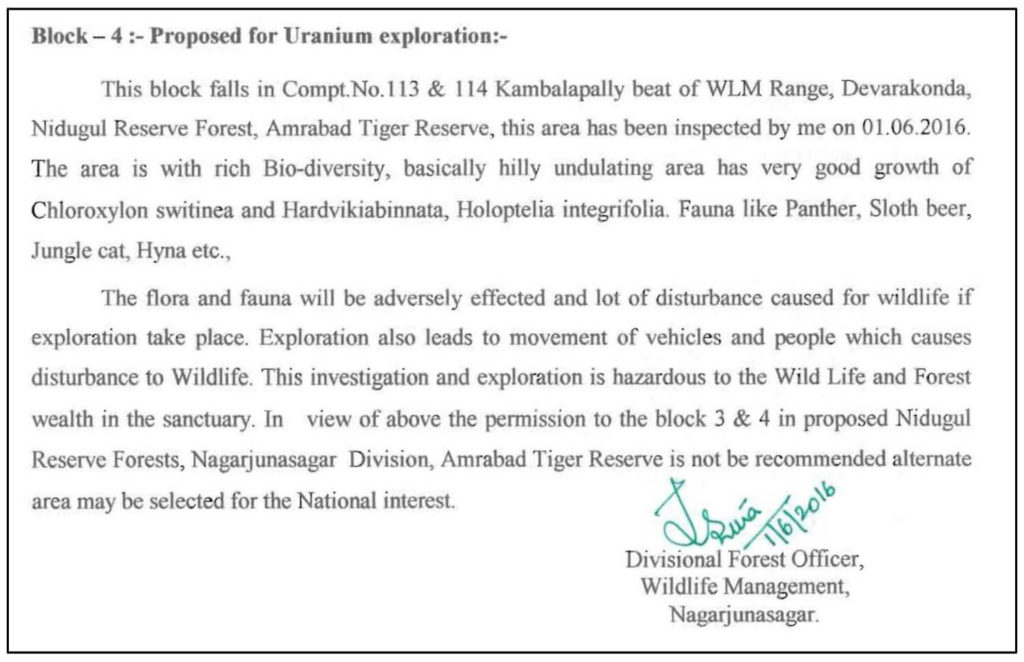
On the other hand, the Divisional Forest Officer of Achampet recommended the proposal since exploration did not involve felling of trees or habitat destruction. He also added that only the existent roads/tracks could be used for movement of vehicles, men and machinery, felling of trees or lopping of branches and work after sunset was prohibited. The same has been mentioned in their respective site inspection reports.
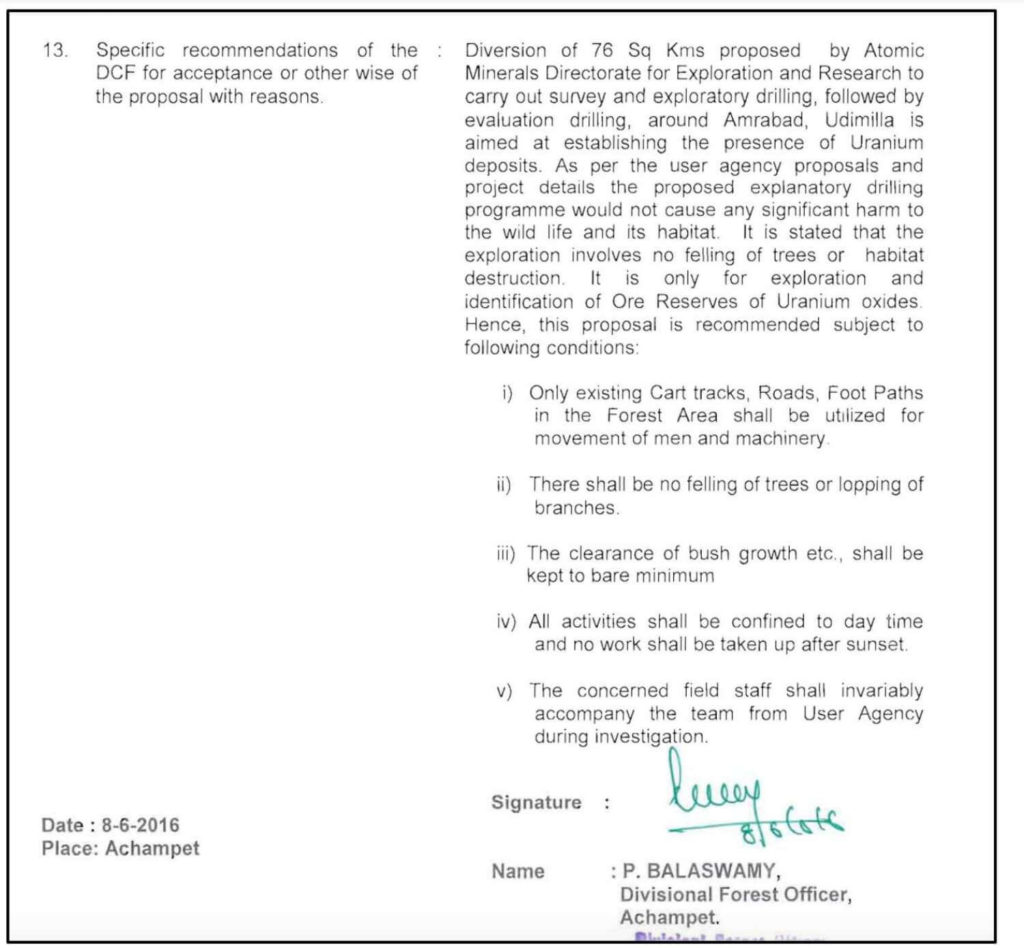
The Chief Conservator of Forests (Field Director) of Amrabad Tiger Reserve, post inspection of sites, did not recommend the project due to the possible damage to environment.
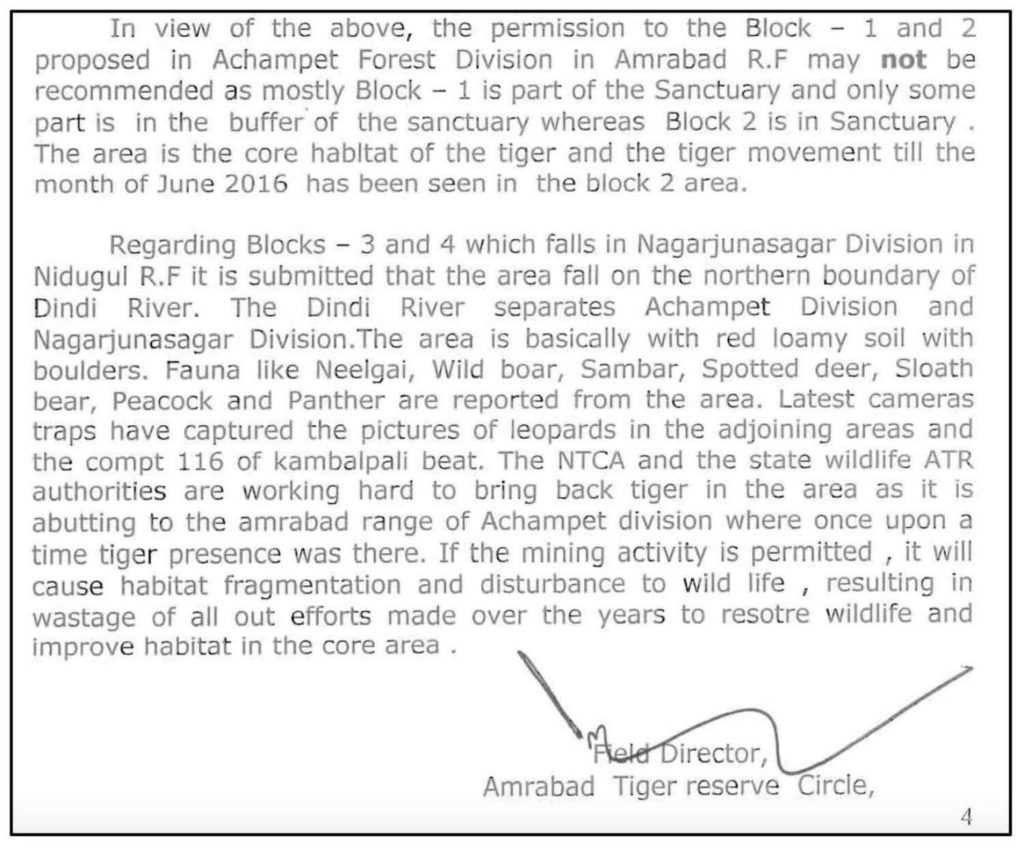
While, there were officers, as noted above, who did not recommend, the Principal Chief Conservator of Forests of Telangana recommended the proposal with the recommendations put forth by the DFO of Achampet.
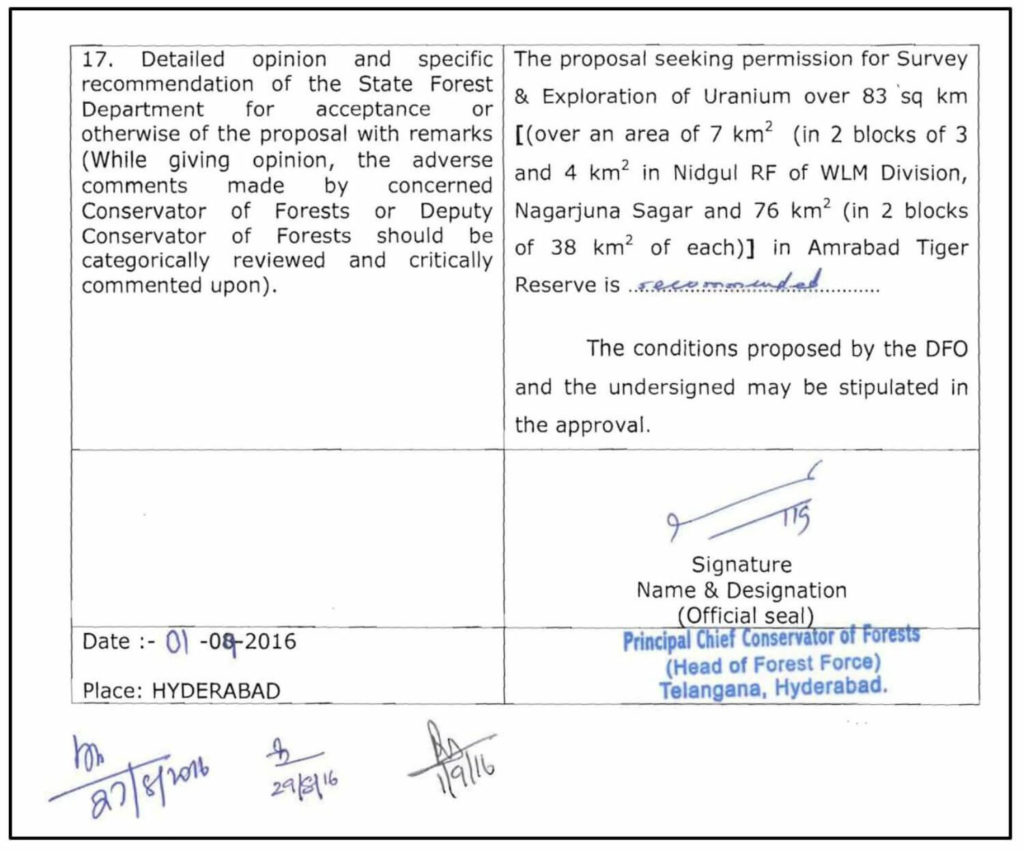
The proposal was approved by the National Board of Wildlife on 02 March 2017 stating that uranium had strategic importance for a developing nation and hence the proposal was recommended along with the conditions and mitigation measures put forth by the State Chief Wildlife Warden. The recommendations were similar to that of the Achampet DFO.

The Forest Advisory Committee (FAC) in its meeting on 22 May 2019, recommended an in-principle approval since the project is of critical importance, despite observing certain deficiencies in the proposal. All the other required documents were asked to be submitted by the state government for a formal approval.
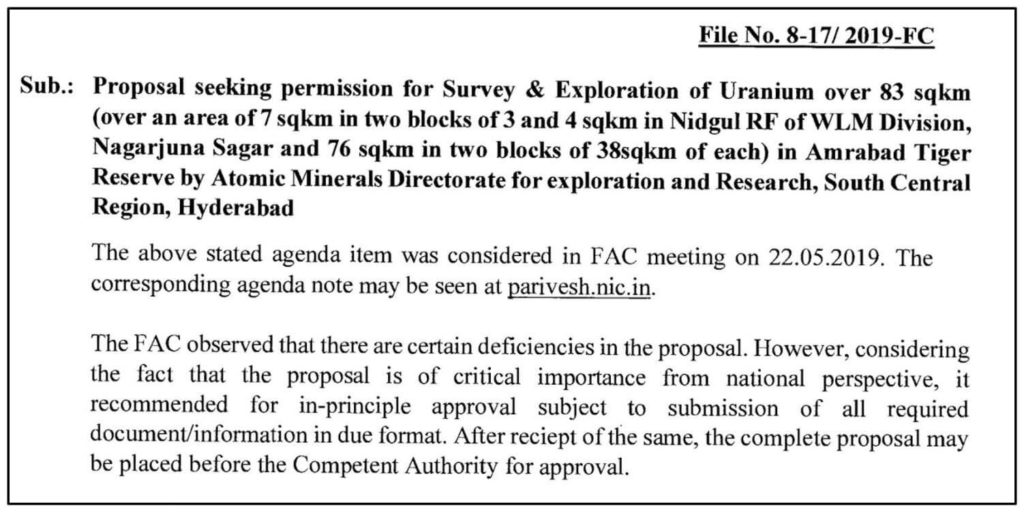
These required documents are to be submitted in due format- that is, proposal be submitted in Form C along with relevant verified documents. In an amendment made to the Forest (Conservation) Amendment Rules in 2014, a new ‘Form C’ was introduced exclusively to be filled by the user agency for seeking prior approval by State Government and other authorities for prospecting minerals in forest area. In this form, details pertaining to the machinery to be used, estimate of mineral, details of vegetation, wildlife and more needs to be filled. On 03 September 2019, the Deputy Inspector General of Forests wrote to the State Government requesting them to furnish the compliance report soon so that further action can be taken.
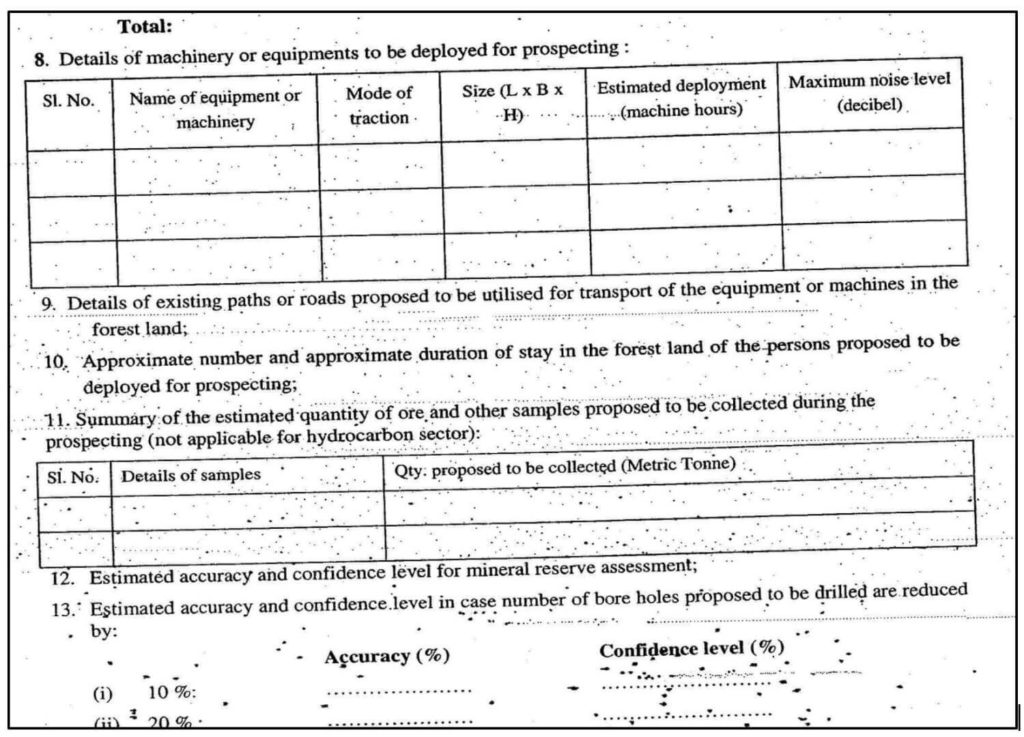
There have been various media reports that about 4000 boreholes of 4 to 6 inch diameter would be drilled in order to ascertain the Uranium presence in the forest land of the Nallamalas and that the project would be implemented over a period of five years.
However, on 16 September 2019, Telangana State Legislative Assembly passed a resolution which requested the Central Government to not grant permission for mining operations in Amrabad Tiger Reserve. As things stand, the formal approval for exploration will only be given once the requisite documents are submitted by the state government.
Featured Image: Uranium Exploration issue in Nallamalas



1 Comment
Pingback: Timeline Explainer: What is the ‘Uranium Exploration’ issue in Nallamalas all about? - Fact Checking Tools | Factbase.us